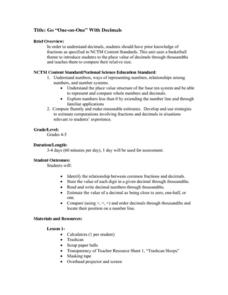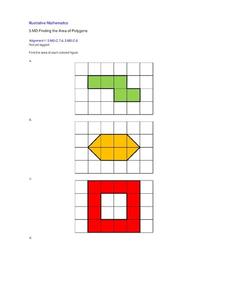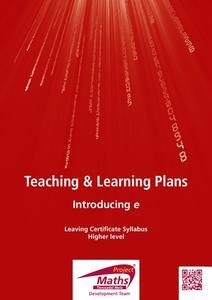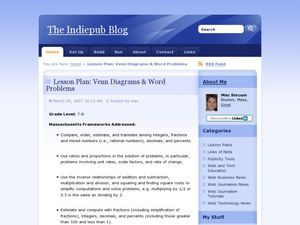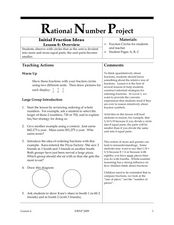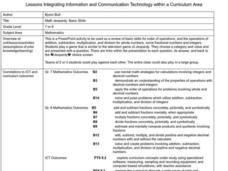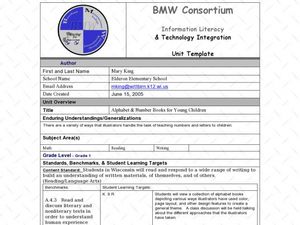Curated OER
Multiplying Mixed Numbers
in this math worksheet, learners combine the factors of mixed numbers in order to get the correct products. The answers are also accessible.
Curated OER
Fractals Teachers' Notes
When you see a flower or a tree in nature do you see the math? This web resource contains many ideas for using fractals in a math class including Sierpinski’s triangle, Koch's Snowflake, and the Jurassic Park Fractal. Additionally, it...
CK-12 Foundation
CK-12 Middle School Math Concepts - Grade 6
Twelve chapters cover a multitude of math concepts found in the Common Core standards for sixth grade. Each title provides a brief explanation of what you will find inside the chapter—concepts from which you can click on and learn more...
National Security Agency
Go One-on-One with Decimals
Shoot and score with three basketball-themed lessons about decimals. Young mathematicians compare game statistics, make trash can hoops, and play a data spinner game to practice identifying digits and values within decimal numbers.
Noyce Foundation
Time to Get Clean
It's assessment time! Determine your young mathematicians' understanding of elapsed time with this brief, five-question quiz.
Arizona Department of Education
Area and Perimeter of Regular and Irregular Polygons
Extend young mathematicians' understanding of area with a geometry lesson on trapezoids. Building on their prior knowledge of rectangles and triangles, students learn how to calculate the area of trapezoids and other...
Curated OER
Finding the Area of Polygons
Third graders are exposed to finding the area of polygons by decomposing figures and recomposing them into rectangles. This strategy allows children to expand on their prior knowledge of constructing shapes by rearranging parts into...
California Education Partners
Photos
Why do all sizes of pictures not show the same thing? Class members analyze aspect ratios of various sizes of photos. They determine which sizes have equivalent ratios and figure out why some pictures need to be cropped to fit...
Center for Math and Science Education
Pocket Solar System
How in the world can something as big as the solar system possibly fit in your pocket? Complete this simple modeling activity and find out, as young scientists gain an appreciation for the incredible scale of outer space.
Project Maths
Introduction to e
First there was pi and now there's e. A discovery-based lesson helps learners find a pattern in compound interest as the compounding period changes. Their investigation results in the discovery of the number e. The lesson is the first in...
Curated OER
Venn Diagrams & Word Problems
Students explore the concept of Venn Diagrams through word problems. In this Venn Diagram lesson, students solve word problems about groups of people using Venn Diagrams. Students use survey results about MySpace and Facebook in a Venn...
Curated OER
Ordering Parts of a Whole
Students review and discuss the task to be completed and how the rubric is used to evaluate it. They each get 6 paper rectangles, 3 of one color and 3 of another color. They cut the rectangles in half two different ways. They repeat the...
Curated OER
Initial Fraction Ideas Lesson 6: Overview
Young scholars use fraction circles to observe fractions in smaller parts and to complete charting and word problem activities. In this fraction lesson plan, students complete chart problems, word problems, and fraction comparing...
Curated OER
Math Jeopardy: Basic Skills
Students play a PowerPoint activity to be used as a review of basic skills for order of operations, and the operations of addition, subtraction, multiplication, and division for whole numbers, some fractional numbers and integers....
Curated OER
Measuring to the Nearest Inch
Third graders use whole numbers and fractions to make connections between abstractions of the mathematical world and the real world. In this fractions and measurement lesson, 3rd graders identify, quantify groups , and measure distances....
Curated OER
Rainbow Jelly
Students work with teaspoons, tablespoons and fractions of a cup to make their own rainbow jelly, converting between units of volume as required. They recognize the need for a standard unit of volume and measure volume using teaspoons...
Curated OER
Walking Math into the Real World
Young scholars measure an area given a yardstick. They also convert inches into a fractions of a foot and use data to create a linear graph.
Curated OER
Estimating With Fire
Students solve problems with percents, decimals and fractions. In this algebra instructional activity, students convert between fractions, percents and decimals. They estimate their answers and calculate their answer.
Curated OER
Musical Whole Numbers
Fourth graders participate in a musical chair activity in which they practice identifying whole numbers. In this number sense lesson, 4th graders listen to a song and must get in the order of the number they hold on an index card...
Curated OER
Conversions: Metrics Made Easy
Students convert standard units of measurement to metric units using tape measures, meter sticks, rulers, and online conversion calculators.
Curated OER
Alphabet & Number Books for Young Children
First graders create either an alphabet or number book using Kid Pix software. For this alphabet and/or number unit, 1st graders design a themed alphabet and/or number book using the Kid Pix software over the course of three weeks....
Curated OER
Counting on Counting
Students recognize that counting tells how many objects are in the set irrespective of how they are arranged or the order in which they are counted. They solve problems involving one more or less to a given set using their knowledge of...
Curated OER
Conversions: Metrics Made Easy
Young scholars, in groups, measure and record each other's height. They identify measurement conversion methods and use online resources to convert measured heights to multiple systems.
Curated OER
All Shapes and Sizes
Sixth graders recognize international paper formats, especially the A series
Carry out practical measuring tasks on sheets of paper and Find patterns in the lengths of the sides of standard paper formats. They use patterns relating to...



